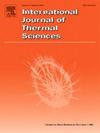利用激光工程微通道优化水池沸腾传热:实验和 RSM 建模分析
IF 4.9
2区 工程技术
Q1 ENGINEERING, MECHANICAL
International Journal of Thermal Sciences
Pub Date : 2025-02-23
DOI:10.1016/j.ijthermalsci.2025.109806
引用次数: 0
摘要
本文章由计算机程序翻译,如有差异,请以英文原文为准。

Optimizing pool boiling heat transfer with laser-engineered microchannels: Experimental and RSM modeling analysis
This study investigates the Pool Boiling Heat Transfer (PBHT) characteristics of distilled water using modified stainless steel surfaces with laser-processed microchannels. An experimental setup was designed and verified to conduct tests at atmospheric pressure across various heat fluxes ranging from 10 to 150 kW/m2 in the nucleate PBHT regime. The microchannel surfaces, which were created using laser technology, had widths between 200 μm and 1000 μm. The experimental results demonstrated a substantial improvement in the Heat Transfer Coefficient (HTC) compared to polished surfaces, with narrow microchannels showing greater enhancement. Specifically, the enhancement ratios of the HTC were 94.3 %, 66.3 %, 44.5 %, 28.5 %, and 21.7 % at microchannel widths of 200, 400, 600, 800, and 1000 μm, respectively, at the highest heat flux. The study employed Response Surface Methodology (RSM) to optimize the PBHT system variables, aiming to achieve an optimal HTC. The quadratic model developed using RSM revealed significant interactions between the variables, with an R2 value of 0.9981 for HTC, indicating a high degree of fit. The RSM analysis highlighted that smaller microchannel widths and higher heat fluxes significantly enhance the heat transfer performance, with the model predictions closely aligning with the experimental data. The optimal conditions predicted by RSM were a microchannel width of 217 μm and a heat flux of 146 kW/m2, resulting in an HTC of 43.93 kW/m2K and an ΔT of 3.27 °C. This study underscores the effectiveness of RSM in optimizing complex heat transfer processes, offering valuable insights for enhancing PBHT performance through surface modification.
求助全文
通过发布文献求助,成功后即可免费获取论文全文。
去求助
来源期刊

International Journal of Thermal Sciences
工程技术-工程:机械
CiteScore
8.10
自引率
11.10%
发文量
531
审稿时长
55 days
期刊介绍:
The International Journal of Thermal Sciences is a journal devoted to the publication of fundamental studies on the physics of transfer processes in general, with an emphasis on thermal aspects and also applied research on various processes, energy systems and the environment. Articles are published in English and French, and are subject to peer review.
The fundamental subjects considered within the scope of the journal are:
* Heat and relevant mass transfer at all scales (nano, micro and macro) and in all types of material (heterogeneous, composites, biological,...) and fluid flow
* Forced, natural or mixed convection in reactive or non-reactive media
* Single or multi–phase fluid flow with or without phase change
* Near–and far–field radiative heat transfer
* Combined modes of heat transfer in complex systems (for example, plasmas, biological, geological,...)
* Multiscale modelling
The applied research topics include:
* Heat exchangers, heat pipes, cooling processes
* Transport phenomena taking place in industrial processes (chemical, food and agricultural, metallurgical, space and aeronautical, automobile industries)
* Nano–and micro–technology for energy, space, biosystems and devices
* Heat transport analysis in advanced systems
* Impact of energy–related processes on environment, and emerging energy systems
The study of thermophysical properties of materials and fluids, thermal measurement techniques, inverse methods, and the developments of experimental methods are within the scope of the International Journal of Thermal Sciences which also covers the modelling, and numerical methods applied to thermal transfer.
 求助内容:
求助内容: 应助结果提醒方式:
应助结果提醒方式:


